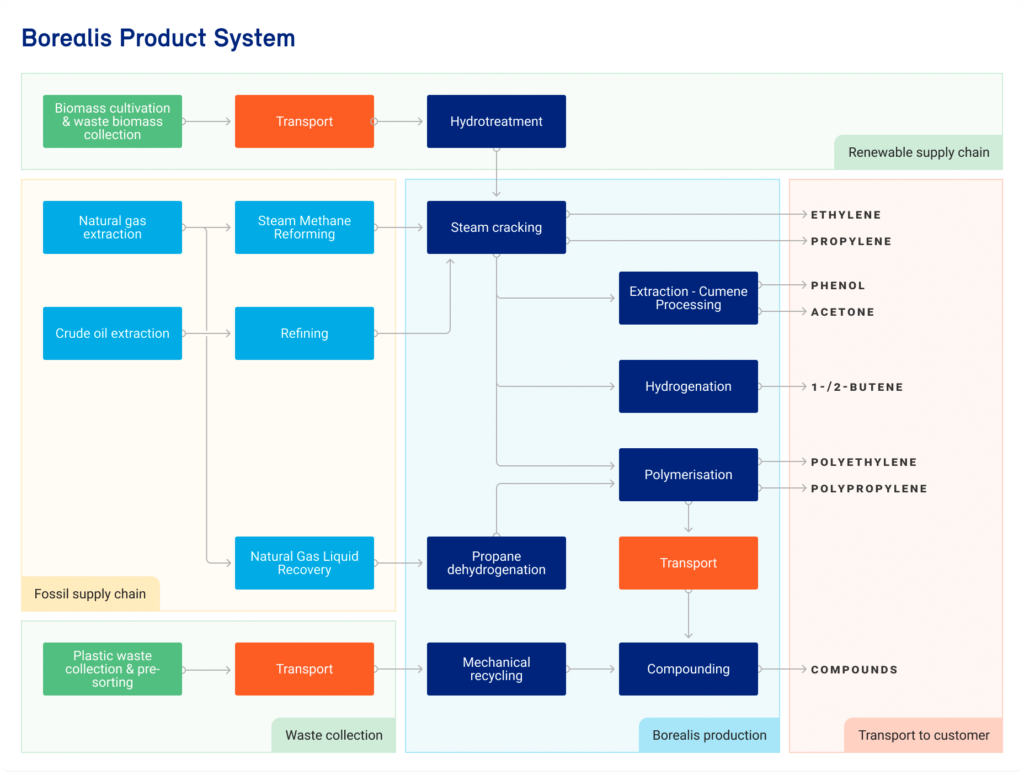How does Neoni work?
Overview of Methodology
The Global Warming Potentials (GWP) of Borealis’ base chemicals and reactor grade polymers are calculated within cradle-to-gate Life Cycle Assessments (LCAs) performed based on the rules laid down in the ISO standards on LCA: ISO 14040:2006 and ISO 14044:2006.
The GWP represents the carbon footprint and includes all relevant greenhouse gas emissions and removals, expressed as carbon dioxide equivalents (CO2e). Neoni takes the cradle-to-gate GWP result from these LCAs (1) to provide customers with a partial carbon footprint for various products. Neoni also calculates the carbon footprint of transport from the Borealis factory gate to the customer if required (2) and adds the carbon footprint of the compounding process in the case of compound products.
The cradle-to-gate system boundary includes all stages from extraction of natural resources up to the point where the product is ready for transportation to the customer. Background data used in the cradle-to-gate LCAs are mainly taken from the Ecoinvent database (3). All processes included in the base chemicals and polymer production system (4) and calculation are shown below. Currently, only products manufactured at our European facilities are included in Neoni.

Step by step
- Fossil supply chain
- Fossil feedstock is processed via dehydrogenation and steam cracking units. The carbon footprint of this upstream supply chain, together with the hydrogen supply to the hydrotreatment process, is based on secondary data.
- Renewable supply chain
- Borealis sources 2nd generation renewable feedstock, i.e. from non-food crops and waste. This feedstock is further processed in a hydrotreatment plant to produce bio propane and bio naphtha. The carbon footprint of this upstream supply chain is based on secondary data.
- Waste collection
- Waste collection is based on the collection systems of Germany and Austria. A pre-sorting step occurs to separate the waste into different fractions, generating the desired feedstock for the recycling plant. Waste collection and presorting are based on secondary data.
- Borealis production
- Primary data from Borealis' production sites in Europe are used in the life cycle assessments that inform Neoni. For products from renewable feedstocks, the Mass Balance Model is used to save identical volume of fossil feedstock by replacing it with renewable feedstock. All BornewablesTM polymers are certified by ISCC Plus and are traceable to source.
Footnotes
- The partial carbon footprint results of products from renewable feedstock sources are based on Borealis’ plants in Belgium, Finland and Sweden for the reference year 2019 and have been calculated within a critically reviewed cradle-togate LCA study in accordance with ISO 14040:2006 and 14044:2006. The GWP is calculated using the the EF 3.0 impact assessment method. The partial carbon footprint results for all fossil feedstock-based reactor grade polyolefins and olefins produced at our European locations are for the reference year 2021 and have been calculated within a critically reviewed eco-profile study in accordance with ISO14040:2006 and ISO14044:2006 as well as the PlasticsEurope Eco-profiles program and Methodology V3.1 (2022) for uncompounded polymer resins and reactive polymer precursors. The GWP is calculated using the the EF 3.0 impact assessment method. The partial carbon footprint results for compound grades are calculated within Neoni. To the best of our knowledge, the calculation has been performed in accordance with the ISO 14040:2006 and ISO14044:2006 standards. A critical review of the compound grade result has not been performed. The partial carbon footprint results of mechanically recycled grades produced at Borealis’ mechanical recycling plants in Germany and Austria are for the reference year 2019 and have been calculated in within a critically reviewed cradle-to-gate LCA study in accordance with ISO 14040:2006 and 14044:2006. The GWP is calculated using the IPCC 2013 (AR5) characterization factors. The characterisation factors applied in the calculation are based on the GWP for a 100-year time horizon. In all cases, the appropriate cut off criteria and allocation choices for multi-functional systems are made where applicable and detailed in the LCA reports (where already available). For compounds, Neoni adds the carbon footprint of the compounding process at various Borealis sites in Europe and includes the carbon footprint for the upstream production of other material components such as talc and glass fibre. In calculating the partial (cradle-to-gate) carbon footprint of a compound grade, a cut off criteria of 1% is applied, consistent with the methodology described in the respective LCA studies. For more information on the performed LCA studies or methodology, please reach out to us.
- Transport CO2e emissions are added based on emission factors defined in the GLEC Framework, developed by the Global Logistics Emissions Council (GLEC).
- The database version depends on the year in which the LCA was performed. Currently, Ecoinvent 3.6, 3.7.1 and 3.8 have been used.
- The product system shown here represents all processes contained within Borealis' current production environment in Europe. The product system here does not reflect that the production of any specific product grade includes all the processes / steps shown.